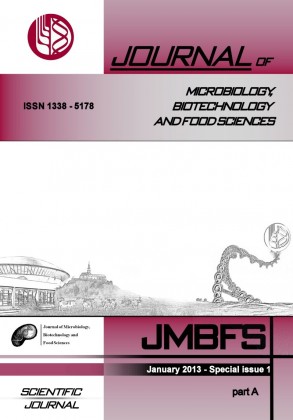FORTIFICATION OF SUNFLOWER PLANTS (HELIANTHUS ANNUUS FORTIFICATION OF SUNFL
Keywords:
selenium, sunflower, foliar application, achenes yield, achenes qualityAbstract
Selenium is a trace element which in small amounts is necessary for human and animal nutrition. In the organism it helps a number of antioxidant enzymes to function normally. In many parts of the world, including the Central European region, its content in agricultural products is very low. Attempts are therefore made to increase its content and cover human requirements with biologically valuable products by incorporating selenium into the system of plant nutrition. In a vegetation trial established in 2010 and 2011 we explored the effect of foliar applications of Se (IV) on achenes yields and on content of selenium in the seeds and the uptake of selenium by the sunflower stand. Solutions of sodium selenite at 0.16 and 0.5 g Se.he-1 were applied at rates 50 and 150 g Se.ha-1 at the beginning of elongation growth (stage R-1). Sunflower achenes yields were significantly influenced by the weather in the experimental years. In 2011 sunflower production was by 29.4% lower than in 2010. Se fortification in dose 50 g Se.ha-1 increased sunflower achenes yield by 3.1%. The higher dose of selenium (150 g Se.ha-1) reduced yields by 6.8% compared with the no-fertilized treatment. Due to the effect of foliar Se nutrition the content of selenium in sunflower achenes increased highly significantly from 123 µg.kg-1 to 6,004 µg.kg-1 of achenes. The weight of 1000 achenes, oil content and content of palmitic, palmitoleic, oleic, linoleic acids were not significantly affected by selenium application. Fortification of Se increased stearic acid content from 3.16% to 3.47%.Downloads
Download data is not yet available.
Downloads
Published
2013-02-01
How to Cite
Å karpa, P. (2013). FORTIFICATION OF SUNFLOWER PLANTS (HELIANTHUS ANNUUS FORTIFICATION OF SUNFL. Journal of Microbiology, Biotechnology and Food Sciences, 2(special issue 2), 1569–1579. Retrieved from https://office2.jmbfs.org/index.php/JMBFS/article/view/7488
Issue
Section
Biotechnology
License
Copyright (c) 2013 Petr Å karpa

This work is licensed under a Creative Commons Attribution 4.0 International License.
All papers published in the Journal of Microbiology, Biotechnology and Food Sciences are published under a CC-BY licence (CC-BY 4.0). Published materials can be shared (copy and redistribute the material in any medium or format) and adapted (remix, transform, and build upon the material for any purpose, even commercially) with specifying the author(s).

